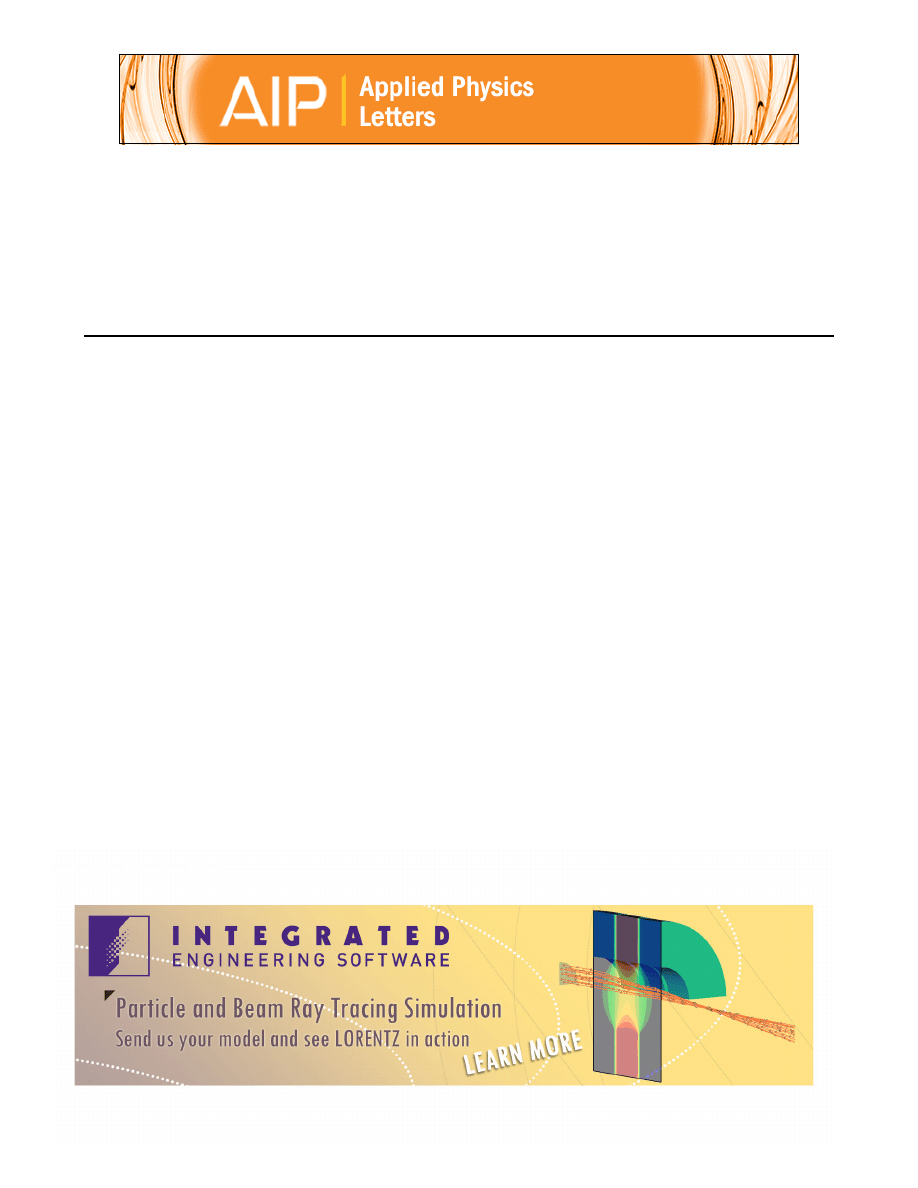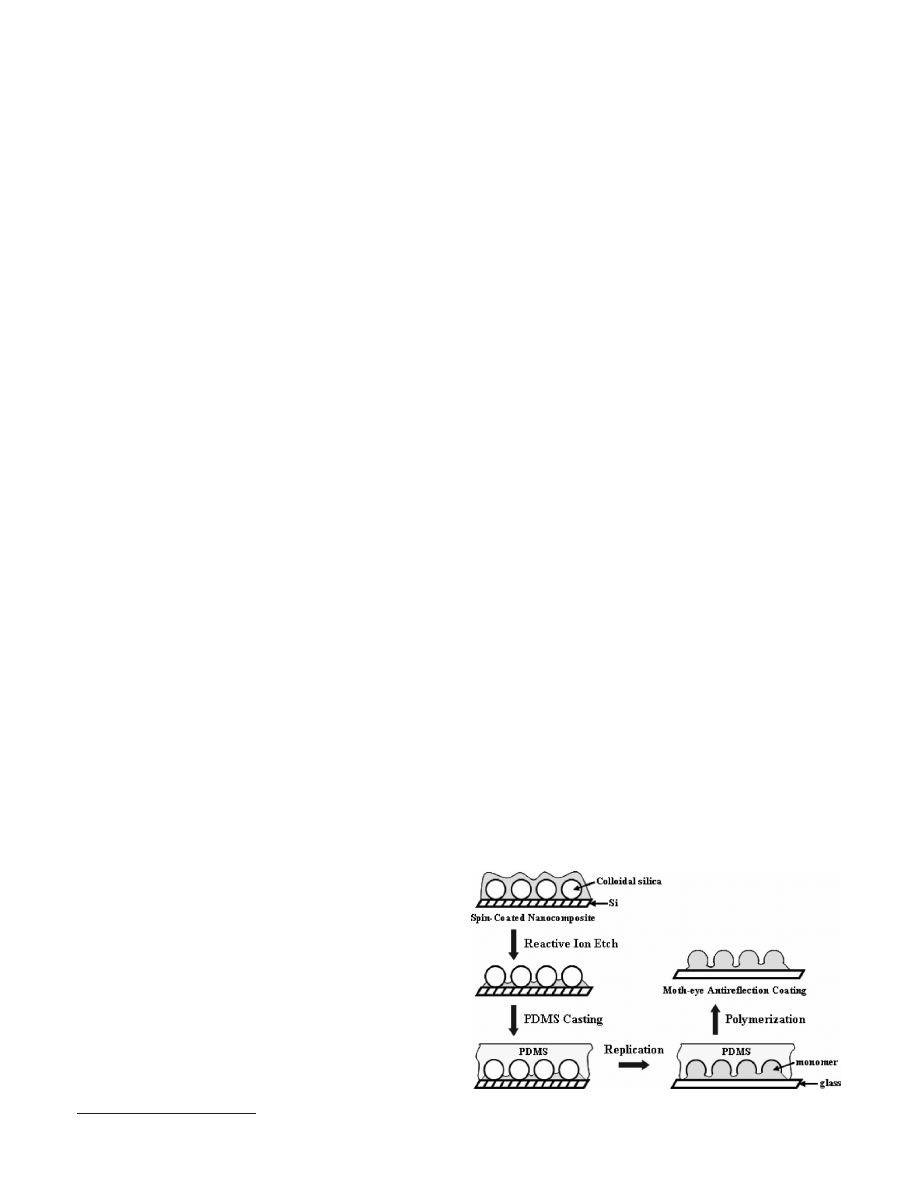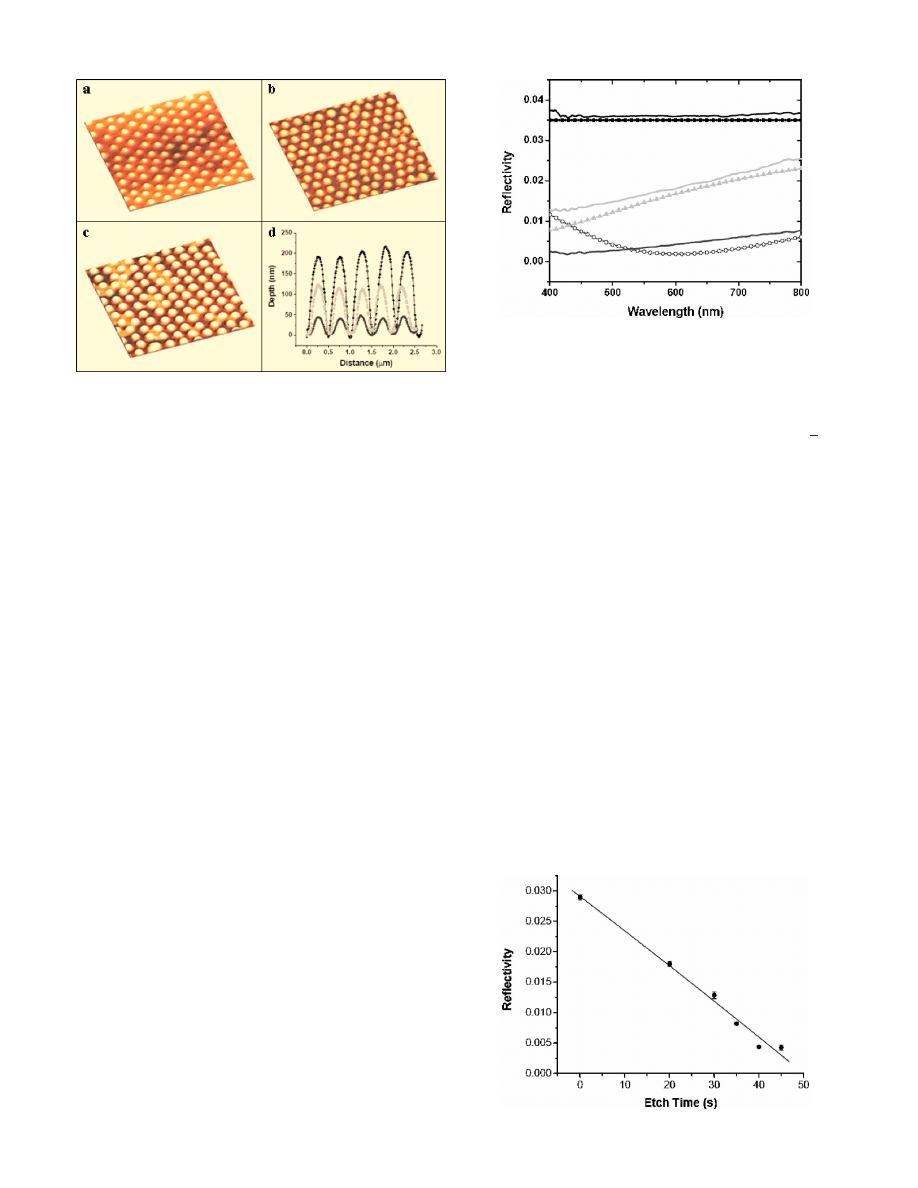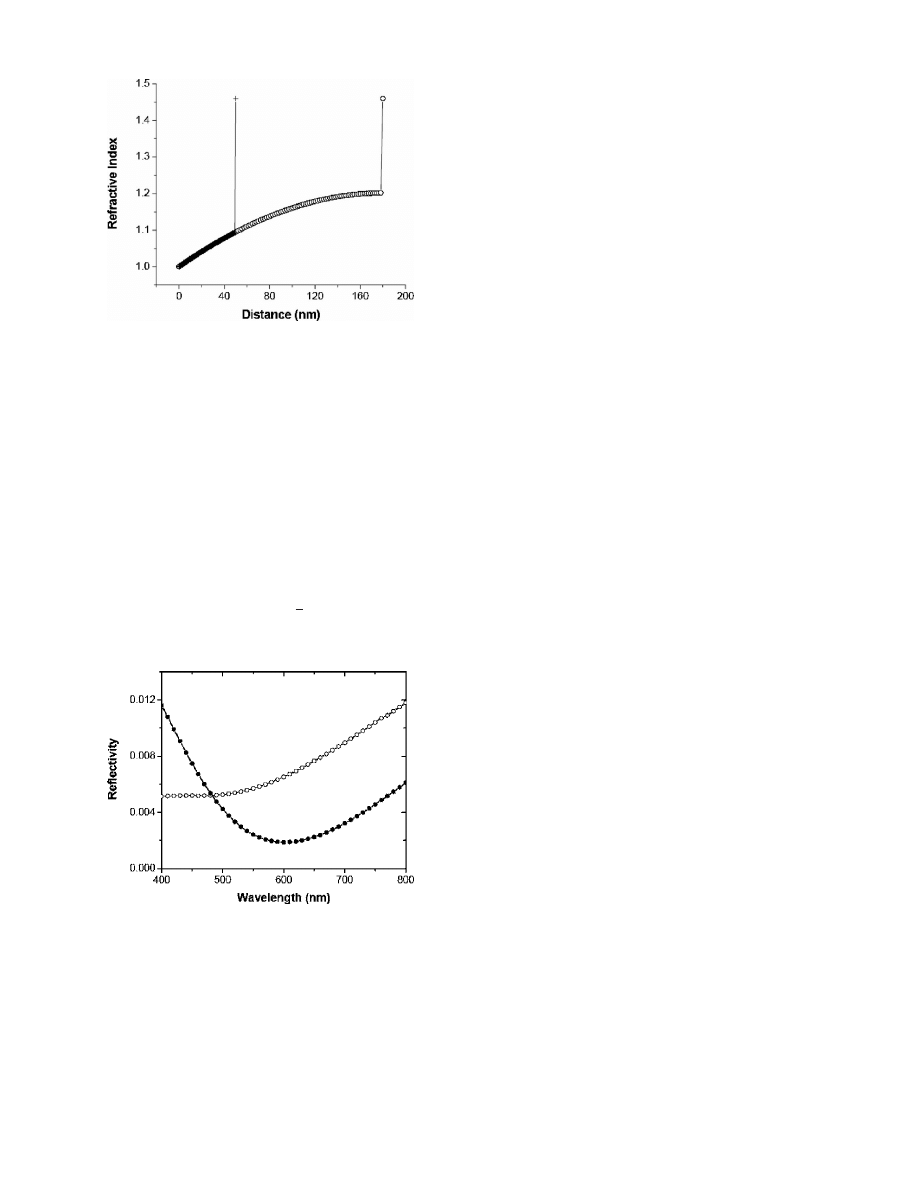
Self-assembled biomimetic antireflection coatings
,
, and
91, 101108 (2007); doi: 10.1063/1.2783475
http://dx.doi.org/10.1063/1.2783475
http://scitation.aip.org/content/aip/journal/apl/91/10?ver=pdfcov
This article is copyrighted as indicated in the abstract. Reuse of AIP content is subject to the terms at: http://scitation.aip.org/termsconditions. Downloaded to IP:
89.69.60.15 On: Wed, 13 Nov 2013 19:03:28

Self-assembled biomimetic antireflection coatings
Nicholas C. Linn, Chih-Hung Sun, and Peng Jiang
Department of Chemical Engineering, University of Florida, Gainesville, Florida 32611
Bin Jiang
Department of Mathematics and Statistics, Portland State University, Portland, Oregon 97201
共Received 30 July 2007; accepted 20 August 2007; published online 6 September 2007兲
The authors report a simple self-assembly technique for fabricating antireflection coatings that
mimic antireflective moth eyes. Wafer-scale, nonclose-packed colloidal crystals with remarkable
large hexagonal domains are created by a spin-coating technology. The resulting polymer-embedded
colloidal crystals exhibit highly ordered surface modulation and can be used directly as templates to
cast poly
共dimethylsiloxane兲 共PDMS兲 molds. Moth-eye antireflection coatings with adjustable
reflectivity can then be molded against the PDMS master. The specular reflection of replicated
nipple arrays matches the theoretical prediction using a thin-film multilayer model. These
biomimetic films may find important technological application in optical coatings and solar cells.
© 2007 American Institute of Physics.
关DOI:
Periodic optical microstructures are abundant in biologi-
cal systems and have provided enormous inspiration for
scientists
to
mimic
natural
structures
for
practical
applications.
To name just a few, Morpho butterflies use
multiple layers of cuticle and air as natural photonic crystals
to produce striking blue color,
inspiring the development of
chemical sensors for detecting trace amount of vapors.
Some nocturnal insects
共e.g., moths兲 use arrays of nonclose-
packed nipples with sub-300-nm size as antireflection coat-
ings
共ARCs兲 to reduce reflectivity from their compound
Artificial ARCs are widely used in monitors, car dash-
boards, optical components, and solar cells.
Existing an-
tireflection
technologies,
such
as
quarter-wavelength
multilayer films and nanoporous coatings
共e.g., phase-
separated polymers and nanoparticle and polyelectrolyte
multilayers
兲 often perform suboptimally or are expensive to
Inspired by the natural photonic structures, moth-eye
ARCs with subwavelength protrusion arrays have been
widely explored.
However, current lithography-based
fabrication techniques
共e.g., photolithography or interference
lithography
兲 in creating sub-300 nm features are costly and
are limited by either low resolution or small sample size.
Self-assembly in synthetic materials provides an inexpen-
sive, simple to implement, inherently parallel, and high
throughput alternative to lithography in creating periodic
microstructures.
Unfortunately, most of the traditional self-
assembly techniques are not compatible with standard micro-
fabrication,
impeding
scale-up
to
an
industrial-scale
Additionally, conventional self-assembly
is limited to the creation of close-packed structures, whereas
natural
moth-eye
ARCs
exhibit
nonclose-packing
Recently, we have developed a versatile spin-coating
technology that combines the simplicity and cost benefits of
bottom-up self-assembly with the scalability and compatibil-
ity of standard top-down microfabrication in creating a large
variety of nanostructured materials.
The technology is
based on shear-aligning concentrated colloidal suspensions
using standard spin-coating equipment, enabling the produc-
tion of wafer-scale, nonclose-packed colloidal crystals. We
have also demonstrated that spin-coated colloidal arrays can
be used as structural templates to replicate a large variety of
functional
nanostructures
including
metallic
nanohole
magnetic nanodots,
macroporous polymers,
mi-
crovial arrays,
and more. For instance, the modulated sur-
face features of spin-coated colloidal crystals have been
demonstrated as two-dimensional templates to create wafer-
scale metallic gratings with crystalline arrays of nanovoids.
Here we extend our previous work on spin-coating-
enabled templating nanofabrication to develop a scalable
nonlithographic approach to mass-fabricate large-area, moth-
eye ARCs with nonclose-packed microstructures and adjust-
able reflectivity. A schematic outline of the templating pro-
cedures is shown in Fig.
. The fabrication of wafer-scale,
nonclose-packed colloidal crystals embedded in poly
共ethoxy-
lated trimethylolpropane triacrylate
兲 共PETPTA兲 matrix is
performed according to Ref.
. The resulting crystals can be
easily and reproducibly created over arbitrarily large areas in
minutes. The long-range periodic surface protrusions of the
shear-aligned crystals
关similar to Fig.
兴 can be easily
transferred to a poly
共dimethylsiloxane兲 共PDMS兲 共Sylgard
184, Dow Corning
兲 mold. The solidified PDMS mold can
then be peeled off and put on top of ETPTA monomer sup-
a
兲
Electronic mail: pjiang@che.ufl.edu
FIG. 1. Schematic illustration of the templating procedures for making
moth-eye antireflection coatings.
APPLIED PHYSICS LETTERS 91, 101108
共2007兲
0003-6951/2007/91
共10兲/101108/3/$23.00
© 2007 American Institute of Physics
91, 101108-1
This article is copyrighted as indicated in the abstract. Reuse of AIP content is subject to the terms at: http://scitation.aip.org/termsconditions. Downloaded to IP:
89.69.60.15 On: Wed, 13 Nov 2013 19:03:28

ported by a glass slide with spacers
共double-stick tape, thick-
ness of
⬃0.1 mm兲 in between. ETPTA monomer is polymer-
ized for 2 s using a Xenon pulsed UV curing system. After
peeling off PDMS mold, ETPTA nipple arrays coated glass
slide can be made. The flexible PDMS mold enables the
creation of microstructured coatings on both planar and
curved substrates.
The protrusion depth
共⬃50 nm兲 of a replicated PETPTA
array from the spin-coated nanocomposite film is shallow
compared to the radius of templating silica spheres
共⬃180 nm兲, as revealed by the atomic force microscope
共AFM兲 image 关Fig.
兴, and its corresponding depth profile
共bottom curve兲 is shown in Fig.
. The polymer matrix of
spin-coated nanocomposites can be plasma-etched
共using an
Unaxis Shuttlelock reactive ion etcher
共RIE兲/inductively
coupled plasma ICP operating at 40 mTorr oxygen pressure,
40 SCCM
共SCCM denotes cubic centimeter per minute at
STP
兲 flow rate, and 100 W兲 to adjust the height of the pro-
truded portions of silica spheres, resulting in good control
over the depth of replicated nipples. Figures
and
show PETPTA nipple arrays replicated from the same nano-
composite sample, as shown in Fig.
, after 20 and 45 s
RIE etching, respectively. The shape of nipples in the latter
sample is close to hemispherical, as revealed by the depth
profile
共top curve兲 in Fig.
The specular optical reflectivity of the replicated nipple
arrays are evaluated using visible-near-IR reflectivity mea-
surement at normal incidence. An Ocean Optics HR4000
high resolution fiber optic UV-visible-near-IR spectrometer
with
a
reflection
probe
is
used
for
reflectance
measurements.
The resulting reflectivity is calibrated using
a STAN-SSL low-reflectivity specular reflectance standard
共Ocean Optics兲. Figures
and
illustrate the excellent con-
trol over the antireflection performance of the replicated
nipple arrays by simply adjusting the RIE etching time
共i.e.,
height of nipples
兲. The hemispherical-like nipple arrays 共dark
gray curve in Fig.
兲 show significantly smaller reflectivity
than that of a flat control sample
共black curve兲 for the whole
visible spectrum.
A thin-film multilayer model
has also been developed
to calculate the specular reflectance of the replicated nipple
arrays and then compared with experimental spectra. The
nipple lattice is assumed to be hexagonal and the distance
between the centers of the neighboring nipples is
冑
2d.
Since the distance of the nipples is small with respect to the
wavelength of light, light propagation is governed by the
effective refractive index of the nipple array, which can be
calculated from effective medium theory.
We first divide
the whole hemisphere cap layer in 100 layers and calculate
the effective refractive index for each layer. The reflectance
of each layer can then be calculated using a matrix multipli-
cation procedure for a stack of thin layers as shown in Chap.
2 of Ref.
. Figure
shows that the simulated spectra
共dot-
ted lines
兲 match the experimental spectra 共solid line兲 and the
reflection from the PETPTA/glass interface due to index mis-
match might contribute to the small discrepancy between
them.
The good and adjustable antireflection performance of
the replicated nipple arrays can be explained by mapping the
effective refractive index across the height of nipples
共Fig.
兲. For featureless polymer film, the refractive index is
sharply changed from 1.0 to 1.46 across the air-polymer in-
terface, leading to high reflectance. For nipples with 50 nm
height
共cross兲 that are replicated directly from spin-coated
nanocomposites without RIE etching, the effective refractive
index is continuously changed from 1.0
共nipple peaks兲 to
1.09
共nipple troughs兲, then sharply increased to 1.46, result-
FIG. 2.
共Color online兲 AFM images and corresponding depth profiles of
replicated nipple arrays at different RIE etching times.
共a兲 0 s. 共b兲 20 s. 共c兲
45 s. 360 nm diameter silica spheres are used as templates.
FIG. 3. Experimental
共solid兲 and calculated 共dotted兲 specular optical reflec-
tivity at normal incidence. Black: flat PETPTA. Light gray: 20 s RIE etch,
110 nm spherical cap. Dark gray: 45 s RIE etch, 180 nm hemispherical cap.
FIG. 4. Dependence of the normal-incidence optical reflectivity at 600 nm
vs RIE etching time performed on spin-coated colloidal crystal-polymer
nanocomposites.
101108-2
Linn et al.
Appl. Phys. Lett. 91, 101108
共2007兲
This article is copyrighted as indicated in the abstract. Reuse of AIP content is subject to the terms at: http://scitation.aip.org/termsconditions. Downloaded to IP:
89.69.60.15 On: Wed, 13 Nov 2013 19:03:28

ing in reduced reflectivity
共Fig.
兲; while for hemispherical
nipples
共unfilled circle兲, the final step is moderate—from
1.20 to 1.46, thus leading to minimal reflectivity.
Natural moth-eye nipples are nonclose packed,
while
bottom-up self-assembly typically produces close-packed ar-
rays. To evaluate which structure is better for antireflective
application, we compare the antireflection performance be-
tween nonclose-packed and close-packed hemispherical
nipple arrays with the same height
共180 nm兲 by simulation
共Fig.
兲. The nonclose-packed arrays show lower reflectivity
when the wavelength of light is larger than the distance be-
tween the neighboring nipples
共
冑
2d,
⬃500 nm兲. Further
simulation shows that this is a general rule for all particle
sizes and we will conduct systematic experimental and the-
oretical investigations on this issue in our future work.
In summary, we have developed a simple yet scalable
self-assembly approach for fabricating efficient moth-eye an-
tireflection
coatings
with
adjustable
reflectivity
and
nonclose-packed microstructures, which are not easily avail-
able by traditional self-assembly approaches. The specular
reflection of nipple arrays matches the theoretical prediction
using a thin-film multilayer model. These biomimetic coat-
ings may find important technological application in optical
devices and solar cells.
This work was supported in part by the NSF under Grant
No. CBET-0651780, the start-up funds from the University
of Florida, and the UF Research Opportunity Incentive Seed
Fund.
1
K. H. Jeong, J. Kim, and L. P. Lee, Science 312, 557
共2006兲.
2
P. Vukusic and J. R. Sambles, Nature
共London兲 424, 852 共2003兲.
3
J. Aizenberg, D. A. Muller, J. L. Grazul, and D. R. Hamann, Science 299,
1205
共2003兲.
4
R. A. Potyrailo, H. Ghiradella, A. Vertiatchikh, K. Dovidenko, J. R.
Cournoyer, and E. Olson, Nat. Photonics 1, 123
共2007兲.
5
T. L. Sun, L. Feng, X. F. Gao, and L. Jiang, Acc. Chem. Res. 38, 644
共2005兲.
6
D. G. Stavenga, S. Foletti, G. Palasantzas, and K. Arikawa, Proc. R. Soc.
London, Ser. B 273, 661
共2006兲.
7
J. Hiller, J. D. Mendelsohn, and M. F. Rubner, Nat. Mater. 1, 59
共2002兲.
8
M. Ibn-Elhaj and M. Schadt, Nature
共London兲 410, 796 共2001兲.
9
S. Walheim, E. Schaffer, J. Mlynek, and U. Steiner, Science 283, 520
共1999兲.
10
J. Q. Xi, M. F. Schubert, J. K. Kim, E. F. Schubert, M. F. Chen, S. Y. Lin,
W. Liu, and J. A. Smart, Nat. Photonics 1, 176
共2007兲.
11
B. G. Prevo, E. W. Hon, and O. D. Velev, J. Mater. Chem. 17, 791
共2007兲.
12
S. Chattopadhyay, L. C. Chen, and K. H. Chen, Crit. Rev. Solid State
Mater. Sci. 31, 15
共2006兲.
13
P. B. Clapham and M. C. Hutley, Nature
共London兲 244, 281 共1973兲.
14
G. A. Ozin and A. C. Arsenault, Nanochemistry: A Chemical Approach to
Nanomaterials
共RSC, Cambridge, 2005兲.
15
J. Y. Shiu, C. W. Kuo, P. L. Chen, and C. Y. Mou, Chem. Mater. 16, 561
共2004兲.
16
Z. Z. Wu, J. Walish, A. Nolte, L. Zhai, R. E. Cohen, and M. F. Rubner,
Adv. Mater.
共Weinheim, Ger.兲 18, 2699 共2006兲.
17
F. C. Cebeci, Z. Z. Wu, L. Zhai, R. E. Cohen, and M. F. Rubner, Langmuir
22, 2856
共2006兲.
18
S. M. Yang, S. G. Jang, D. G. Choi, S. Kim, and H. K. Yu, Small 2, 458
共2006兲.
19
P. T. Hammond, Adv. Mater.
共Weinheim, Ger.兲 16, 1271 共2004兲.
20
H. Y. Koo, D. K. Yi, S. J. Yoo, and D. Y. Kim, Adv. Mater.
共Weinheim,
Ger.
兲 16, 274 共2004兲.
21
B. G. Prevo, Y. Hwang, and O. D. Velev, Chem. Mater. 17, 3642
共2005兲.
22
P. Jiang, Angew. Chem., Int. Ed. 43, 5625
共2004兲.
23
P. Jiang, Chem. Commun.
共Cambridge兲 2005, 1699.
24
P. Jiang, Langmuir 22, 3955
共2006兲.
25
P. Jiang and M. J. McFarland, J. Am. Chem. Soc. 126, 13778
共2004兲.
26
P. Jiang and M. J. McFarland, J. Am. Chem. Soc. 127, 3710
共2005兲.
27
P. Jiang, T. Prasad, M. J. McFarland, and V. L. Colvin, Appl. Phys. Lett.
89, 011908
共2006兲.
28
H. A. Macleod, Thin-Film Optical Filters, 3rd ed.
共Institute of Physics,
Bristol, 2001
兲, p. 40.
FIG. 5. Comparison of the change of calculated effective refractive index
from the nipple peaks
共n
eff
= n
air
= 1
兲 to the nipple troughs 共n
eff
= n
PETPTA
= 1.46
兲 between hemispherical 共unfilled circle兲 and 50-nm-height spherical
cap
共cross兲 nipple arrays. The diameter of colloidal particles is 360 nm.
FIG. 6. Comparison of the calculated specular optical reflectivity at normal
incidence between nonclose-packed
共filled circle兲 and close-packed 共unfilled
circle
兲 hemispherical nipple arrays. The diameter of colloidal particles is
360 nm.
101108-3
Linn et al.
Appl. Phys. Lett. 91, 101108
共2007兲
This article is copyrighted as indicated in the abstract. Reuse of AIP content is subject to the terms at: http://scitation.aip.org/termsconditions. Downloaded to IP:
89.69.60.15 On: Wed, 13 Nov 2013 19:03:28
Wyszukiwarka
Podobne podstrony:
Gor±czka o nieznanej etiologii
02 VIC 10 Days Cumulative A D O Nieznany (2)
Abolicja podatkowa id 50334 Nieznany (2)
45 sekundowa prezentacja w 4 ro Nieznany (2)
4 LIDER MENEDZER id 37733 Nieznany (2)
Mechanika Plynow Lab, Sitka Pro Nieznany
katechezy MB id 233498 Nieznany
2012 styczen OPEXid 27724 Nieznany
metro sciaga id 296943 Nieznany
Mazowieckie Studia Humanistyczn Nieznany (11)
cw 16 odpowiedzi do pytan id 1 Nieznany
perf id 354744 Nieznany
DO TEL! 5= Genetyka nadci nieni Nieznany
Opracowanie FINAL miniaturka id Nieznany
3 Podstawy fizyki polprzewodnik Nieznany (2)
interbase id 92028 Nieznany
Mbaku id 289860 Nieznany
Probiotyki antybiotyki id 66316 Nieznany
więcej podobnych podstron